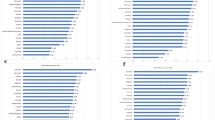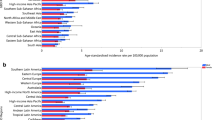Abstract
Background:
In healthy subjects increasing body mass index (BMI) leads to greater mortality from a range of causes. Following onset of specific diseases, however, the reverse is often found: called the ‘obesity paradox’. But we recently observed the phenomenon called the ‘paradox within the paradox’ for stroke patients.
Objective:
The objective of our study was to examine the effect of each unit increase in BMI on renal cancer-specific survival (CSS), cancer-specific mortality, overall survival (OS) and overall mortality.
Design:
Random-effects generalized least squares models for trend estimation were used to analyze the data. Eight studies, comprising of 8699 survivals of 10 512 renal cell carcinoma (RCC) patients met the inclusion criteria, including 5 on CSS and 3 on OS.
Results:
The association of BMI with CSS and OS was non-linear (P<0.0001, P=0.004, respectively). We observed that CSS increased in relation to BMI, indicating that there was the obesity paradox in RCC. However, each unit increase in BMI over 25 was associated with decreased OS, indicating that RCC may also exhibit a paradox within the paradox.
Conclusions:
Inconsistent effects of increases in BMI on CSS and OS, as previously observed for stroke, creates a paradox (different directions of mortality for different causes) within the obesity paradox.
This is a preview of subscription content, access via your institution
Access options
Subscribe to this journal
Receive 12 print issues and online access
$259.00 per year
only $21.58 per issue
Buy this article
- Purchase on Springer Link
- Instant access to full article PDF
Prices may be subject to local taxes which are calculated during checkout



Similar content being viewed by others
References
Berrington de Gonzalez A, Hartge P, Cerhan JR, Flint AJ, Hannan L, MacInnis RJ et al. Body-mass index and mortality among 1.46 million white adults. N Engl J Med 2010; 363: 2211–2219.
Whitlock G, Lewington S, Sherliker P, Clarke R, Emberson J, Halsey J et al. Body-mass index and cause-specific mortality in 900 000 adults: collaborative analyses of 57 prospective studies. Lancet 2009; 373: 1083–1096.
Flegal KM, Kit BK, Orpana H, Graubard BI . Association of all-cause mortality with overweight and obesity using standard body mass index categories: a systematic review and meta-analysis. JAMA 2013; 309: 71–82.
Kalantar-Zadeh K, Abbott KC, Salahudeen AK, Kilpatrick RD, Horwich TB . Survival advantages of obesity in dialysis patients. Am J Clin Nutr 2005; 81: 543–554.
Oreopoulos A, Padwal R, Kalantar-Zadeh K, Fonarow GC, Norris CM, McAlister FA . Body mass index and mortality in heart failure: a meta-analysis. Am Heart J 2008; 156: 13–22.
Choi Y, Park B, Jeong BC, Seo SI, Jeon SS, Choi HY et al. Body mass index and survival in patients with renal cell carcinoma: a clinical based cohort and meta analysis. Int J Cancer 2013; 132: 625–634.
Kalantar-Zadeh K, Block G, Humphreys MH, Kopple JD . Reverse epidemiology of cardiovascular risk factors in maintenance dialysis patients. Kidney Int 2003; 63: 793–808.
Johansen KL, Young B, Kaysen GA, Chertow GM . Association of body size with outcomes among patients beginning dialysis. Am J Clin Nutr 2004; 80: 324–332.
Abbott KC . Reverse epidemiology and obesity in maintenance dialysis patients. Kidney Int 2003; 64: 1138–1138.
Park J, Ahmadi SF, Streja E, Molnar MZ, Flegal KM, Gillen D et al. Obesity paradox in end-stage kidney disease patients. Prog Cardiovasc Dis 2014; 56: 415–425.
De Schutter A, Lavie CJ, Milani RV . The impact of obesity on risk factors and prevalence and prognosis of coronary heart disease-the obesity paradox. Prog Cardiovasc Dis 2014; 56: 401–408.
Kalantar-Zadeh K, Block G, Horwich T, Fonarow GC . Reverse epidemiology of conventional cardiovascular risk factors in patients with chronic heart failure. J Am Coll Cardiol 2004; 43: 1439–1444.
Clark AL, Fonarow GC, Horwich TB . Obesity and the obesity paradox in heart failure. Prog Cardiovasc Dis 2014; 56: 409–414.
Uretsky S, Messerli FH, Bangalore S, Champion A, Cooper-Dehoff RM, Zhou Q et al. Obesity paradox in patients with hypertension and coronary artery disease. Am J Med 2007; 120: 863–870.
Jahangir E, De Schutter A, Lavie CJ . Low weight and overweightness in older adults: risk and clinical management. Prog Cardiovasc Dis 2014; 57: 127–133.
Prieto-Alhambra D, Premaor MO, Avilés FF, Castro AS, Javaid MK, Nogués X et al. Relationship between mortality and BMI after fracture: a population based study of men and women aged ≥40 years. J Bone Miner Res 2014; 29: 1737–1744.
Andersen KK, Olsen TS . The obesity paradox in stroke: lower mortality and lower risk of readmission for recurrent stroke in obese stroke patients. Int J Stroke 2015; 10: 99–104.
Kim BJ, Lee S-H, Ryu W-S, Kim CK, Lee J, Yoon B-W . Paradoxical longevity in obese patients with intracerebral hemorrhage. Neurology 2011; 76: 567–573.
Vemmos K, Ntaios G, Spengos K, Savvari P, Vemmou A, Pappa T et al. Association between obesity and mortality after acute first-ever stroke the obesity–stroke paradox. Stroke 2011; 42: 30–36.
Kalantar-Zadeh K, Rhee CM, Amin AN . To legitimize the contentious obesity paradox. Mayo Clinic Proc 2014; 89: 1033–1035.
Hainer V, Aldhoon-Hainerová I . Obesity paradox does exist. Diabetes Care 2013; 36 (Supplement 2): S276–S281.
Oreopoulos A, Kalantar-Zadeh K, Sharma AM, Fonarow GC . The obesity paradox in the elderly: potential mechanisms and clinical implications. Clin Geriatr Med 2009; 25: 643–659.
Bagheri M, Speakman JR, Shabbidar S, Kazemi F, Djafarian K . A dose-response meta-analysis of the impact of body mass index on stroke and all cause mortality in stroke patients: a paradox within a paradox. Obes Rev 2015; 16: 416–423.
Brookman-May S, Kendel F, Hoschke B, Wieland WF, Burger M, Rößler W et al. Impact of body mass index and weight loss on cancer-specific and overall survival in patients with surgically resected renal cell carcinoma. Scand J Urol Nephrol 2011; 45: 5–14.
Sunela KL, Kataja MJ, Kellokumpu-Lehtinen PI . Influence of body mass index and smoking on the long-term survival of patients with renal cell cancer. Clin Genitourin Cancer 2013; 11: 458–464.
Orsini N, Bellocco R, Greenland S . Generalized least squares for trend estimation of summarized dose-response data. Stata J 2006; 6: 40.
Hamling J, Lee P, Weitkunat R, Ambühl M . Facilitating meta analyses by deriving relative effect and precision estimates for alternative comparisons from a set of estimates presented by exposure level or disease category. Stat Med 2008; 27: 954–970.
Greenland S, Longnecker MP . Methods for trend estimation from summarized dose-response data, with applications to meta-analysis. Am J Epidemiol 1992; 135: 1301–1309.
Haferkamp A, Pritsch M, Bedke J, Wagener N, Pfitzenmaier J, Buse S et al. The influence of body mass index on the long-term survival of patients with renal cell carcinoma after tumour nephrectomy. BJU Int 2008; 101: 1243–1246.
Jeon HG, Jeong IG, Lee JH, Lee CJ, Kwak C, Kim HH et al. Prognostic value of body mass index in Korean patients with renal cell carcinoma. J Urol 2010; 183: 448–454.
Steffens S, Ringe KI, Schroeer K, Lehmann R, Rustemeier J, Wegener G et al. Does overweight influence the prognosis of renal cell carcinoma? Results of a multicenter study. Int J Urol 2013; 20: 585–592.
Sung HH, Jeon SS, Park SY, Jeong BC, Seo SI, Lee HM et al. Impact of body mass index in Korean patients with renal cell carcinoma. Cancer Causes Control 2012; 23: 505–511.
Donat SM, Salzhauer EW, Mitra N, Yanke BV, Snyder ME, Russo P . Impact of body mass index on survival of patients with surgically treated renal cell carcinoma. J Urol 2006; 175: 46–52.
Park B, Jeong BC, Seo SI, Jeon SS, Choi HY, Lee HM . Influence of body mass index, smoking, and blood pressure on survival of patients with surgically-treated, low stage renal cell carcinoma: a 14-year retrospective cohort study. J Korean Med Sci 2013; 28: 227–236.
Parker AS, Lohse CM, Cheville JC, Thiel DD, Leibovich BC, Blute ML . Greater body mass index is associated with better pathologic features and improved outcome among patients treated surgically for clear cell renal cell carcinoma. Urology 2006; 68: 741–746.
Reeves GK, Pirie K, Beral V, Green J, Spencer E, Bull D et al. Cancer incidence and mortality in relation to body mass index in the Million Women Study: cohort study. BMJ 2007; 335: 1134.
Hakimi AA, Furberg H, Zabor EC, Jacobsen A, Schultz N, Ciriello G et al. An epidemiologic and genomic investigation into the obesity paradox in renal cell carcinoma. J Natl Cancer Inst 2013; 105: 1862–1870.
McGee, Daniel L . Body mass index and mortality: a meta-analysis based on person-level data from twenty-six observational studies. Ann Epidemiol 2005; 15: 87–97.
Padwal R, McAlister FA, McMurray JJ, Cowie MR, Rich M, Pocock S et al. The obesity paradox in heart failure patients with preserved versus reduced ejection fraction: a meta-analysis of individual patient data. Int J Obes 2013; 38: 1110–1114.
Sharma A, Vallakati A, Einstein AJ, Lavie CJ, Arbab-Zadeh A, Lopez-Jimenez F et al. Relationship of body mass index with total mortality, cardiovascular mortality and myocardial infarction after coronary revascularization: evidence from a meta-analysis. J Am Coll Cardiol 2014; 63: 1080–1100.
Tajer CD, . RAC director’s letter. The obesity paradox. intention of making a reasonable suggestion for secondary prevention. Revista Argentina de Cardiologia 2012; 80: 195–204.
Morgan TM, Tang D, Stratton KL, Barocas DA, Anderson CB, Gregg JR et al. Preoperative nutritional status is an important predictor of survival in patients undergoing surgery for renal cell carcinoma. Eur Urol 2011; 59: 923–928.
Löser C, Lübbers H, Mahlke R, Lankisch PG . cme: involuntary weight loss in elderly people. Dtsch Arztebl 2007; 104: 3411–3420.
Acknowledgements
The study was supported by Tehran University of Medical Sciences. We gratefully thank Dr Peter Lee for providing us with technical assistance.
Author contributions
MB designed research, analyzed data, wrote paper and had primary responsibility for final content. JRS has developed overall research plan, wrote paper and had responsibility for critical revision. FS had hands-on data collection. KD was responsible for interpretation of data, drafting of manuscript and critical revision.
Author information
Authors and Affiliations
Corresponding author
Ethics declarations
Competing interests
The authors declare no conflict of interest.
Rights and permissions
About this article
Cite this article
Bagheri, M., Speakman, J., Shemirani, F. et al. Renal cell carcinoma survival and body mass index: a dose–response meta-analysis reveals another potential paradox within a paradox. Int J Obes 40, 1817–1822 (2016). https://doi.org/10.1038/ijo.2016.171
Received:
Revised:
Accepted:
Published:
Issue Date:
DOI: https://doi.org/10.1038/ijo.2016.171
This article is cited by
-
The m6A modification-mediated OGDHL exerts a tumor suppressor role in ccRCC by downregulating FASN to inhibit lipid synthesis and ERK signaling
Cell Death & Disease (2023)
-
A hint for the obesity paradox and the link between obesity, perirenal adipose tissue and Renal Cell Carcinoma progression
Scientific Reports (2022)
-
Associating the risk of three urinary cancers with obesity and overweight: an overview with evidence mapping of systematic reviews
Systematic Reviews (2021)
-
Body mass index as an independent risk factor for inferior vena cava resection during thrombectomy for venous tumor thrombus of renal cell carcinoma
World Journal of Surgical Oncology (2019)
-
Increasing the rigor of obesity research publications
International Journal of Obesity (2017)



